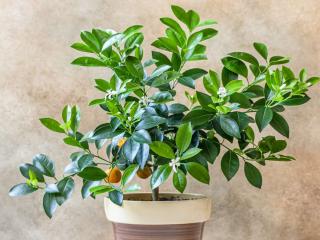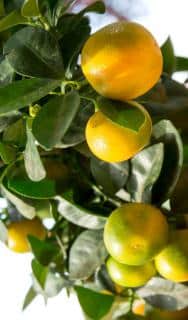

Calamondin or calamondino is an apartment orange tree very well suited to living inside our heated homes.
Core Calamondin facts
Name: Citrus mitis
Family: Rutaceae (Rue family)
Height: 3 to 6 ½ feet (1 to 2 meters)
Exposure: full sun outdoors, indirect sun inside
Soil: soil mix
Foliage: evergreen – Fruit formation: November to March
Planting and repotting, care, watering and pruning are all good habits that will help you to grow a very nice calamondin.
 It is recommended to plant calamondin in a blend of soil mix eventually enriched with fertilizer.
It is recommended to plant calamondin in a blend of soil mix eventually enriched with fertilizer.
An ideal solution is to pour in a layer of gravel, clay pebbles or rocks to ensure that excess water drains well to the bottom.
Make this layer about 1 to 2 inches (3 to 4 cm) thick.
Anticipate re-potting in a pot that is slightly larger than the previous every 2 or 3 years on average.
This small orange tree can only grow directly in the ground in Mediterranean-type climate (dry, warm summer and dry, mild winters), or tropical climates.
If this is the case, mix soil mix together with your garden soil. It’s very important to ensure that your soil drains well.
If it doesn’t drain well, dig a hole that is slightly deeper, and layer gravel, rocks, sand or clay pebbles along the bottom.
It isn’t really necessary to prune it. However, to rebalance the silhouette of your calamondin, prune lightly after repotting, in spring.
The only rule for pruning is that you can give it the shape you want! For instance, style it like a tree with a tallish trunk, or a bushy round shrub! Pleating or trimming as flat espalier are also possible.
Best practices are to:
It is advised to repot every 2 years. This helps replenish soil nutrients that are depleted as the plant consumes them. Watering often washes nutrients out, too.
If ever the pot is too large for repotting, you can go for topdressing. It’s a good enough alternative, but remember to use a richer soil mix than for regular repotting.
Adding citrus-specific fertilizer will greatlyincrease fruit and foliage quality.
Fruit drop occurs pretty often at the beginning, when the plant is young. As it gets older, remember to:
Together, these steps help avoid stress to the plant. It can hold on to its fruits until they’re ripe instead of dropping them on a whim!
Indoors, water, but not too much, as soon as the soil is dry.

If you can, it is good to bring your calamondin out after any risk of freezing has disappeared, from spring until the end of summer.
Indoors, simply set it in a well-lit spot but avoid direct sunlight during the hottest hours.
Also avoid setting it right next to a radiator.
Plan on adding fertilizer for citrus plants regularly in order to greatly increase blooming and fruit formation.
Hi, we bought our Calamondin plant earlier this year already with flowers and some fruits. We replanted it right away to a bigger pot . The flowers did not bear fruits and slowly disappeared. The foliage is nice & green but no more flowers. We cut some of the stems & leaves but still no flowers. I water it sparingly so not to drown it. I had put in small amount of fertilizer when we re-potted it . What am I doing wrong ? By the way, it has about 3 more fruits that I have not harvested. All in all, I only got about 6 to 8 fruits since we bought it. Please help !
Hi Corazon, you’re doing almost everything right! Calamondino is a fickle plant, and it isn’t a heavy producer. From your description, I would simply remember to add fertilizer every fortnight, as you water. Having put some in the pot upon repotting was important, and for sustained blooming and fruiting, regular fertilizing helps. In the wild, roots continuously search for fresh nutrients so you have to replicate this in the pot, too.
Fertilize quite a lot, actually : for example, mature potted citrus trees (5+ years old) need a whole pound (1/2 kg) of nitrogen a year. A two year-old tree only needs 1/4th pound (about 125 g). Ideally, you would spread this out during the entire growing phase, from spring to fall. Note that this amount is the amount of nitrogen, not the amount of fertilizer. Depending on the brand and make, you’ll have to compute how much nitrogen is actually contained in, say, 1 pound (or 1/2 kg) of fertilizer. The label can help you figure it out: a 10-2-6 (NPK) fertilizer is 10% nitrogen, 2% phosphorus, and 6% potassium by weight.
Great options are bone and blood meal: these natural fertilizers contain high amounts of nitrogen and trace elements, too.
In then end, it’s important to realize that the plant needs lots of food and proper watering to produce fruits. Whenever something is lacking or the plant feels stressed, it’ll first sacrifice blooming, then young fruit, then older fruit, then leaves, twigs, etc. in that order. In the same manner, your calamondino, once you’ve given it the perfect environment, will first focus on leaves, then existing fruits, and only when all’s been well for a month or two will it venture into making new flowers again.
Hello. I’ve had my calamondin for a few years now I noticed white stuff in the underside of the leaves. It’s not moving, there’s nothing on top or in the branches. Any advice?
Hi Nana, “white stuff” is almost always scale insects, they’re particularly common on citrus plants. It looks like a white fluff, a bit cottony. If you squish it with a cotton bud or spoon it’s a bit juicy – that’s because there’s a sap-sucking bug under that fluff! The type of scale insects that looks like this is “mealybugs”. Here is an article that explains how to rid your calamondin from scale insects.
My calamondin tree (indoors, since we live in Indiana) looks healthy, and I’ve fertilized it with citrus-specific fertilizer. It occasionally gets a ton of blossoms, but the first time this happened, not a single fruit (which I love in iced tea with sweetener) appeared. The next time it blossomed, I tried taking a Q-tip and brushing each blossom to try to pollinate it (which I suspect wasn’t happening after the first time). This resulted only in a very small number of oranges, but none of them ripened to maturity, but simply dropped off when they were still green. Any hints on how I might obtain oranges from my calamondin?
(If you have time to reply, please do so directly to my email address so I will be sure to see it. Thanks!)
Hi David, calamondin is a rather fickle plant when it comes to fruiting. It drops its fruits as soon as it isn’t happy, be it watering, temperature swings, or lacking nutrients.
– since you’ve given it citrus fertilizer, it should be ok for nutrients, though having a little more potassium might help. You can topdress your pot with a potting mix that has seaweed as an ingredient, and mix in a couple teaspoons (no more) of wood ash (the more noble the wood, the better, i.e. oak and the like).
– a potential reason might be lacking moisture. In the soil, for potted plants, striking a balance isn’t that easy. I suppose you use the “finger test” where you check whether the soil is moist a knuckle deep. If yes, wait another two days, if not, watering time! Set a pail or gallon with water nearby so the water is at room temperature, and collect rainwater to avoid saturating the soil with minerals. Another helpful tip is to increase air moisture around the plant: check out different ways of doing that here.
– the last reason might be a bit more difficult, it’s related to light. Direct sunlight is too harsh, so you’ll need to set it near a window with either morning or evening sun (East or West), and nonetheless ensure lots of light. A grow light might help during the winter months, so that formed fruits don’t drop due to lack of light.
Flowers appear several times, even while fruits are forming on the side, so just keep tweaking the environment until one fruit stays, then two… Keep pollinating, too, but you can also test whether some flowers would still turn to fruit even if you don’t pollinate them (tie a yarn around the branch you don’t pollinate, for instance). Young trees can take up to 6 years before they’re able to sustain a harvest: before that, it’s all just trial runs without much success!
Hi Gaspard,
Your answer, which I’ve just read, is very helpful. I last fertilized the tree about 8 months ago, so perhaps it needs it more often than that. Since the plant stays indoors, I have it on a plant light (2 different kinds, in fact) that is on a timer, which goes off about 8 hours during the night.
The pot does have holes in it to allow excess water to drain on through, and I have been watering it whenever the surface of the soil feels dry. I didn’t know that I should test it to the depth of a knuckle, though. So, perhaps I can make sure to do all the things you mention, and will have success after the tree gets a little older. I purchased it from a Florida nursery about a year and a half ago.
All my best,
David
I was gifted 2 calamondin trees about a metre high. Now the calamondins are drying up on the tree. Should I harvest the crinkled fruits and prune?
How should I prune the tree?
Hello Tina, pruning is mostly only to shape the tree into a more harmonious shape. You can for sure remove crinkled fruits, they won’t get any nicer, so it’s better to prepare for the next batch. It’s quite common for calamondin to shed its fruits when it changes environment, perhaps that’s what is happening to your citrus after moving from the nursery to your home.The goal would be to adjust your care until you find what pleases your particular calamondino most. In pots, it’ll need (citrus) fertilizer on a regular basis, repotting and/or topdressing. Light should be abundant, but not direct sunlight; a thin veil should be enough to cut off direct sun enough to avoid sunburn if ever you’ve only a sun-bathed area to put it in.
My Calamondin tree has been beautiful full of flowers and fruit. I kept it in the house in winter but put it out under shelter in spring.However it has now started dropping leaves and the leaves which are still on the plant are turning yellow at the edges. What is the reason for this? Is it too much water or fertiliser? I don’t want to lose it as I’ve had this little tree for 3 years now. Can you help please?
Thanks Janet
Nice blog regarding the Calamondin tree. Thanks for sharing such a nice blog.
Sure thing! Thanks for the nice comment.